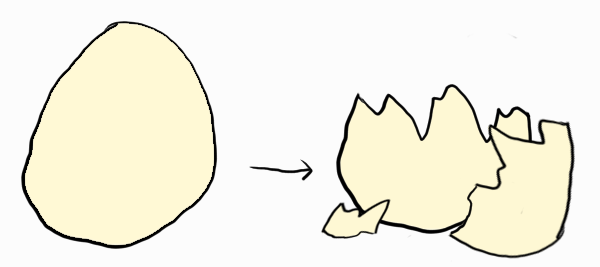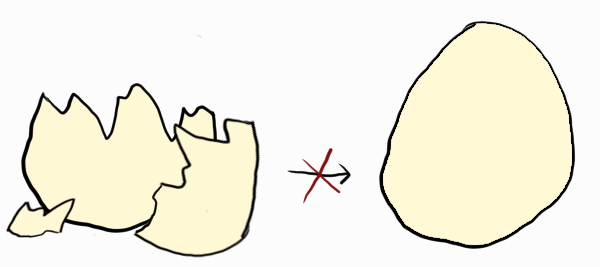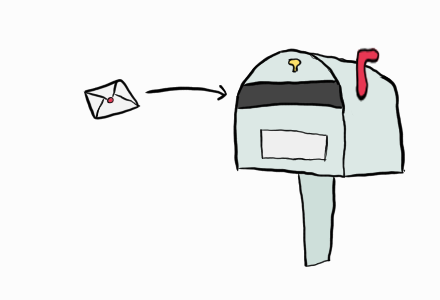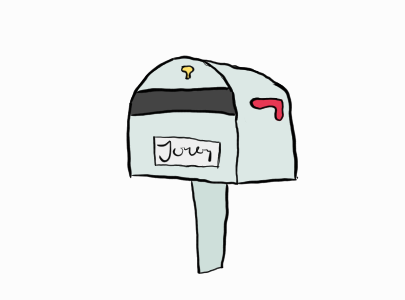A hitchhiker's guide to cryptography
An introduction to cryptography
Don’t Panic.
This chapter serves as an introduction to the cryptographic terms and constructs mentioned in the book. The aim is to give you an idea of what they are and how they might be used in a cryptocurrency context. I won’t go into low-level details of how they work, so you don’t need to know any mathematics or programming to follow along. If this interests you, I hope this introduction will be helpful as a starting point when researching the topic on your own.
Hash functions
Hash functions, or to be more precise cryptographic hash functions, are commonly used in the cryptocurrency space. They’re used as the basis of proof-of-work, to verify the integrity of downloaded files and we used them when we created a timestamped message.
Hashes are one-way functions. As the name implies we can give data to a function to get a result, but we cannot go the other way to get back the original data if we only have the hashed result.
It’s similar to how we can break an egg, but there’s no easy way to “unbreak” it.


In the digital world we can use the popular SHA-256 hash function as an example:
hello → 5891b5b522d5df086d0ff0b110fbd9d21bb4fc7163af34d08286a2e846f6be03But there’s no function to reverse a hash:
084c799cd551dd1d8d5c5f9a5d593b2e931f5e36122ee5c793c1d08a19839cc0 → ???To find out what’s hidden behind the hash we have to try all possibilities:
1 → 4355a46b19d348dc2f57c046f8ef63d4538ebb936000f3c9ee954a27460dd865
2 → 53c234e5e8472b6ac51c1ae1cab3fe06fad053beb8ebfd8977b010655bfdd3c3
...
42 → 084c799cd551dd1d8d5c5f9a5d593b2e931f5e36122ee5c793c1d08a19839cc0Found it! The answer is “42”. But we were lucky that we only had to test 42 possibilities, we could have continued a very long time depending on the input.
Don’t believe me? Then try to guess what message this SHA-256 output comes from, and I can even give you a hint that it’s only spaces, upper- and lower-case letters:
b409d7f485033ac9f52a61750fb0c54331bfdd966338015db25efae50984f88fTo get a sense for how hard it can be to figure out the matching data for a hash, let’s look at Bitcoin mining. Because that’s really what miners do—they calculate SHA-256 hashes with different kinds of input again and again until they find a match. And they don’t require an exact match either, they only want to find a hash with a certain number of leading zeroes.
The current hashrate for Bitcoin is around 113 exahashes per second (2020-02-18). That’s a staggering 113 x 1018, or 133 000 000 000 000 000 000, hashes per second, yet they’re still only expected to find a single solution every 10 minutes.
Even all of Bitcoin’s hashrate, working for millions of years, are not expected to find the reverse of a single hash. Even though there’s theoretically an infinite number of inputs that produce the same hash, it’s computationally infeasible to ever find one, therefore we can consider it practically impossible to reverse a hash.
If you want to give up and see what I encoded in the hash, Iron Man is my favorite superhero
Public-key cryptography
If you jump into the mathematical definitions of public-key cryptography it might look very complicated. While some details are complicated, the cryptography is conceptually simple; it’s a digital version of a locked mailbox.

Cryptographic schemes commonly use a single large number as their secret key, but public-key cryptography uses two keys: the public key, which is like the mailbox, and the private key, which is like the key to the mailbox. Anyone can give you mail—just slide it into the mailbox at the top—but you’re the only one who can read them, because you’re the only with the key to the mailbox.
You encrypt a message by placing it in the mailbox, this way nobody but the owner of the mailbox can decrypt and read it. The owner of the mailbox can also prove they own the mailbox by placing their name on it, an action that requires you to open the mailbox with the key. In digital terms this is how you sign a message.


Large parts of the internet depends on public-key cryptography. For example when you connect to your bank over the internet, this scheme helps ensure that nobody can see how much money you have, who you pay and that you’re the only one that can transfer your money.

I won’t go into details on the mathematics behind public-key cryptography, as I’m not able to without making the explanation needlessly complicated, but if this interests you I encourage you to look it up—I personally find it fascinating.
We’ll look at public-key cryptography in practice when we look at how Bitcoin addresses work.
Bitcoin addresses
The addresses in Bitcoin (and other cryptocurrencies) use public-key cryptography to protect your funds. The address is a public key that everyone can send coins to, but to send coins from an address you need the private key.
This is for example a standard Bitcoin address:
19WoNYNXnfNPmLteC8YmZFsTQoN9gBSbCGWhich corresponds to the public key:
049f6aad24669d180cfe4c974a677407cbf26f03242a09126ebf88621d31f01a218d40fcbcb769b44b014d502a1c9ce8c2ca629bc339fe14b4db56e27e80ac30a7The address could be displayed in various different ways, Bitcoin just happened to do it this way. Using an address is more convenient as it’s shorter and includes error checking codes.
The private key to this address looks like this:
5298e83a0c0884cdcf34294f663220bc73e3c6689e95b53158a9a89e95fd78bbThe private key is just a large number and can be be displayed in different ways. Here’s the same key in the Wallet Import Format, which is shorter and includes error checking codes:
5JSfRE8qNQZTtdwuRx6pxVohC3C3VeAHvzKvLsZWHEGPdW2zF3oIt’s important to note that you should never reveal your private key like this. Don’t take a screenshot of it, email it or post it on social media. Because if someone sees your key, they can steal all the coins from your address. The private key really is the key to the castle, and if you lose it you’ll lose all your funds forever. So please back up your private key somewhere safe (or the more user-friendly seed, but we’ll get to that shortly).
There are other types of addresses and other formats for the private and public keys, and other cryptocurrencies may handle them differently, but the concepts are the same.
The reason Bitcoin uses public-key cryptography for the addresses is because you can sign messages with it. For example if I sign the message:
Jonas sent the moneyWith the private key to the address:
19WoNYNXnfNPmLteC8YmZFsTQoN9gBSbCGI’ll get this signature:
HCZl2+vEZboqXgaVYi1nLNgwoa/INLiEsA2yXe+87j5iFoo/G96m4AoA5dL5T+rTiFKpXHuS5w3rP1IWSPZZv0Q=Which lets you verify that I know the private key to the address, even if I never showed it to you. This can be useful if we’ve sent money to someone and we want to prove who did it.1
This is also what happens in the background when you authorize a transaction; you sign it with your private key and your signature is verified before the transaction is accepted. If the signature doesn’t verify then the transaction is invalid and gets discarded, ensuring that coins can only be spent by the owner of the address.2
Encrypting messages using your bitcoin keys isn’t that common to my knowledge—people typically use protocols such as PGP—but it’s possible. I’ll include a short example for completeness sake.
For example if you want to send me the message:
I secretly love your book!But only want me to be able to read it, you can encrypt it with my public key:
049f6aad24669d180cfe4c974a677407cbf26f03242a09126ebf88621d31f01a218d40fcbcb769b44b014d502a1c9ce8c2ca629bc339fe14b4db56e27e80ac30a7And you’ll get the encrypted message:
QklFMQJ+CTugTvsEmuB7owU3DvC5taXqC5DhsJ3Wq8EmUMHwgsE54GlY1PI9d1R/OoGfq1mG9dcThW5T9fpUtQTY+ogLLvKsrN6ngeulLMrfoyCxFtLTjH78PGSd8eROQ1yPq1k=Which only I can decrypt to the original message. (Since I’ve given out the private key, you can decrypt it as well.)
Seeds
Because private keys aren’t very user-friendly, Bitcoin wallets use seeds. The seed is made up of a sequence of 12, or sometimes 24, words selected from a pre-determined set of 2048 possible words.
This is for example a 12-word seed:
reward tip because lock general culture below strike frog fox chunk indexWhich corresponds to the private key:
KyRoQMYWAtfj5cGLThb1fznm5Utjq7Etmn9DLtdxYCiE3Vntcz3EMuch more user friendly right? Even though memorizing the public key directly is very difficult, you can see that it would not be too difficult to memorize the seed!
In addition to being easy to use, seeds act as a starting point in deterministic wallets to generate multiple private and public key pairs (giving you multiple addresses).
Giving out a new address each time you receive money is useful for privacy purposes, as it makes it harder to connect your transactions with your identity. This is why all modern wallets generates a new address each time you press receive.
Here are for example the first 10 addresses and their private keys of our seed:
| Address | Private key |
19oN2GWEH1uiPz11WyChkUp2che9Z11Q5A | KyRoQMYWAtfj5cGLThb1fznm5Utjq7Etmn9DLtdxYCiE3Vntcz3E |
1LverDkyaWMEyyFHiEWQaJt6UGxRjeBfQR | L1NH4wpuKzafbq2PtVXaGCE8hjc7KGzRfyfYik73APu7kZvdJxUp |
1QHQ8uFrEL29WAkMLQgkoDzHimEQNqubM1 | Kx3c9ZeS2pzYPuLa2NoA14SavnsWpkf1BJDLDu1N52oGoNWgv9KM |
1HiohATeEm6BBeRCgWZ5vY3ZKFrCDsJnt9 | KyCWZEpJ3AYUmB7MGEVvZfr6eiwgag89jmZtHC1tEVv9XynSqmot |
1KJ5oMUEJTyd3igAYjJGvpdVjGDvF1Brc6 | L4exrFikcfgSYm1ZZBkJrbwouLjzrrJB6VPyaH4vyK8cAkK2V2nt |
1DzZJ6R1xXiQ3HJ3BsBAcviVdtUEeiu2UG | Kx37aUKrHRVdinxzHWTK8ebXWeMtRSbtshzonTMTQBrssQ2ms1JV |
134TjnZ8xiu4wxfyy4xQQtiMiKhhe6AVur | KwPqA3XUaWCX2dhRRm4WXArm5DJKXko1ydgwwApJ3BC3dgnQ3Ydg |
12XiJHvYT6TyaWcUhzdcBgqFZc3bNWpYdd | L2WakaNFfBehyL17c13iQwJKR8H1hQtsVvR5jsdugFfj9si8DZm2 |
12MuxMtJb9jbrzMQrr7zDiLYcn6xwaXMkq | L2ScmsyKJYzW2koEPjHmLKzjFMYNfR8UZMifP2yvggrRrJEBU4UJ |
1MqBeJiVW6FqxKbrMq8mVUcukjXWMzuYew | KypFcqzaJRHPwxQfGDiYyJMtAdyKNSQuR78yZPTU57baS42dp4tr |
I reiterate the importance of backing up and protecting your seed. Here are just some ways you could lose your money:
- You have a wallet on your phone but you lose it or it breaks down.
- You’ve written down your seed on paper, but it burns up.
- You forgot where you wrote down your seed.
- Someone finds your seed, and steals your money.
Therefore it’s of utmost importance for you to backup and protect your seed. Ideally you should have multiple encrypted copies in different locations, protected from fire and theft.
Does this sound too difficult? It’s true, there are many pitfalls and it’s easy to do a bad job. But in practice, for reasonably small amounts, it’s enough just to write down your seed somewhere.